An official website of the United States government
 United States Department of Labor
United States Department of Labor
In March 2013, the U.S. Bureau of Labor Statistics published its second and final Green Goods and Services (GGS) survey news release containing detailed economic statistics on industry employment in the green goods and services sector. The GGS survey used the Quarterly Census of Employment and Wages program (QCEW) as a sample frame. This article highlights the 2011 GGS survey results and enhancements of the data collection process. In 2011, the U.S. economy had 3.4 million jobs associated with the production of green goods and services, which represented 2.6 percent of total employment and resulted from an increase of 157,746 jobs from 2010.
In fiscal year 2010, the Bureau of Labor Statistics (BLS) received funding to develop and implement the collection of new data on green jobs. BLS defines green jobs as jobs in businesses that produce goods or provide services that benefit the environment or conserve natural resources. One of the resulting products, the Green Goods and Services (GGS) survey, was an annual publication that used the Quarterly Census of Employment and Wages (QCEW) program as a sample frame. The QCEW program publishes a quarterly count of employment and wages reported by employers, covering 98 percent of U.S. jobs, available at the county, metropolitan statistical area, state, and national levels by industry. The QCEW program also maintains a business register database of all establishments in the United States subject to unemployment insurance taxes. The GGS survey collected data from approximately 120,000 sampled worksites in 325 industries—from the North American Industrial Classification System (NAICS)—identified as potential producers of green goods and services. For additional background information on the history and methodology of the GGS survey, please refer to Dixie Sommers’ article, “BLS green jobs overview”.1
On March 19, 2013, BLS published its second and final detailed economic statistics on industry employment in the green goods and services sector.2 For 2011, BLS reported the U.S. economy had 3.4 million jobs associated with the production of green goods and services; this figure represented 2.6 percent of total employment and showed an increase of 157,746 jobs between 2010 and 2011. This GGS survey release presented the opportunity for BLS to analyze the change in employment within green goods and services industries. This article will focus on the 2011 GGS survey results and enhancements to the data collection process.
In 2011, the United States had 3.4 million jobs associated with the production of green goods and services, accounting for 2.6 percent of total employment. The 3.4 million jobs in 2011 represented an increase of nearly 160,000 green goods and services jobs when compared with the 2010 GGS survey job estimates. Between 2010 and 2011, green goods and services employment increased 4.9 percent, compared with a 1.2-percent increase in total employment. The largest increase was in the construction sector, in which green goods and services employment grew by 26.4 percent, compared with a decrease in total employment of 0.3 percent. Leisure and hospitality experienced the second largest change in green goods and services employment, 14.8 percent, compared with a 2.2 percent increase in total employment. (See table 1.)
| Industry | NAICS | 2010 GGS employment | 2011 GGS employment | Change in GGS employment, 2010‒2011 | Percent change in GGS employment | Percent change in total QCEW employment (1) |
|---|---|---|---|---|---|---|
| Total, all industries | — | 3,243,533 | 3,401,279 | 157,746 (2) | 4.9 | 1.2 |
| Total, all private industries | — | 2,342,562 | 2,515,200 | 172,638 (2) | 7.4 | 1.9 |
| Natural resources and mining | 11, 21 | 63,344 | 64,689 | 1,345 | 2.1 | 5.1 |
| Utilities | 22 | 69,031 | 71,129 | 2,098 | 3.0 | –0.2 |
| Construction | 23 | 385,777 | 487,709 | 101,932 (2) | 26.4 | –0.3 |
| Manufacturing | 31–33 | 492,985 | 507,168 | 14,183 (2) | 2.9 | 1.9 |
| Trade | 42, 44–45 | 205,567 | 223,079 | 17,512 (2) | 8.5 | 1.3 |
| Transportation and warehousing | 48–49 | 242,137 | 238,755 | –3,382 (2) | –1.4 | 2.8 |
| Information | 51 | 33,321 | 29,412 | –3,909 | –11.7 | –1.1 |
| Financial activities | 52, 53 | 462 | 475 | 13 | 2.8 | 0.2 |
| Professional, scientific, and technical services | 54 | 355,386 | 381,981 | 26,595 | 7.5 | 2.9 |
| Management of companies and enterprises | 55 | 62,630 | 69,310 | 6,680 | 10.7 | 3.2 |
| Administrative and waste services | 56 | 330,650 | 335,417 | 4,767 | 1.4 | 4.2 |
| Education and health services | 61, 62 | 28,789 | 26,123 | –2,666 | –9.3 | 2.0 |
| Leisure and hospitality | 71, 72 | 20,642 | 23,696 | 3,054 (2) | 14.8 | 2.2 |
| Other services (except public administration) | 81 | 51,841 | 56,257 | 4,416 | 8.5 | 1.4 |
| Federal government | — | 208,744 | 213,340 | 4,596 | 2.2 | –3.9 |
| State government | — | 256,224 | 248,539 | –7,685 | ‒3.0 | ‒1.1 |
| Local government | — | 436,002 | 424,201 | –11,801 | ‒2.7 | ‒1.6 |
| Notes: (1) Industries may not add to the total because of unclassified employment in the Quarterly Census of Employment and Wages (QCEW) total employment. The unclassified North American Industrial Classification System (NAICS) sector is not shown separately, but it is included in the total. | ||||||
The private sector had 2.5 million green goods and services jobs in 2011, an increase of 172,638 (7.4 percent) from 2010. Manufacturing had 507,168 green goods and services jobs in 2011, the most among any private sector industry. Construction had the largest change in green goods and services employment, increasing by 101,932. (See figure 1.)
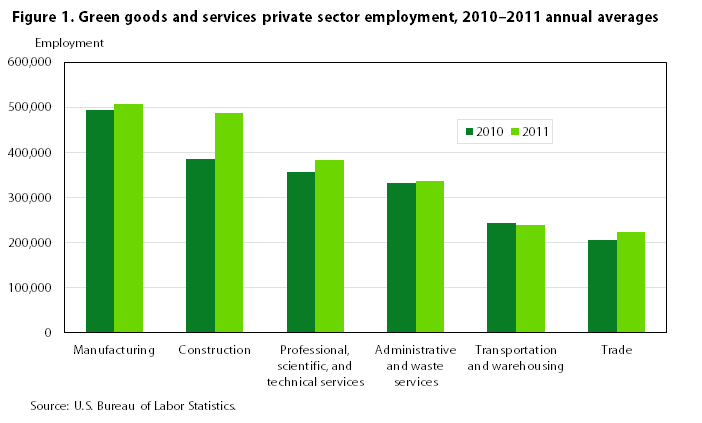
| Industry | 2010 | 2011 |
|---|---|---|
Manufacturing | 492,985 | 507,168 |
Construction | 385,777 | 487,709 |
Professional, scientific, and technical services | 355,386 | 381,981 |
Administrative and waste services | 330,650 | 335,417 |
Transportation and warehousing | 242,137 | 238,755 |
Trade | 205,567 | 223,079 |
In 2011, green goods and services manufacturing jobs accounted for 4.3 percent of all private manufacturing employment in the United States, as measured by the QCEW program. The largest green goods and services employment within manufacturing in 2011 was found in the ventilation, heating, air-conditioning and commercial refrigeration equipment manufacturing industry group (NAICS 3334), with 42,242 green goods and services jobs. This industry group includes the assembly or production of ENERGY STAR-certified appliances. The iron and steel mills and ferroalloy manufacturing (NAICS 3311) and pulp, paper, and paperboard mills (NAICS 3221) industries had the second and third most green goods and services employment within manufacturing, 33,812 and 32,032, respectively.
The manufacturing sector experienced a green goods and services employment growth of 14,183 (2.9 percent). The expansion of green goods and services jobs within manufacturing jobs was driven by the following industry groups: semiconductor and other electronic component manufacturing (NAICS 3344) with 4,963 additional green goods and services jobs, foundries (NAICS 3315) with 1,862 additional green goods and services jobs, and electric lighting equipment manufacturing (NAICS 3351) with 1,816 additional green goods and services jobs. Together, these three industry groups accounted for 60.9 percent of the green goods and services job growth in manufacturing.
Construction had 487,709 green goods and services jobs in 2011, comprising 8.9 percent of the sector’s employment. The sector underwent the largest increase in green goods and services employment from 2010 to 2011, with 101,932 additional green goods and services jobs (26.4 percent). (See table 1 and figure 2.) The composition of employment in construction changed in 2011, because the share of jobs associated with green goods and services significantly increased. Over the year, the total private sector construction employment (as measured by the QCEW program) decreased from 5,489,499 to 5,473,045 (–16,454), while green goods and services jobs increased by 101,932, resulting in a green goods and services percent increase from 7.0 percent in 2010 to 8.9 percent in 2011 (see figure 3).
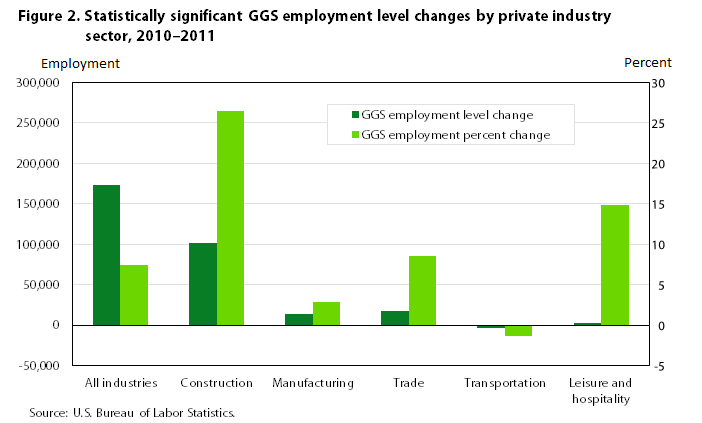
Industry | GGS employment level change | GGS employment percent change |
|---|---|---|
All industries | 172,638 | 7.4 |
Construction | 101,932 | 26.4 |
Manufacturing | 14,183 | 2.9 |
Trade | 17,512 | 8.5 |
Transportation | –3,382 | –1.4 |
Leisure and hospitality | 3,054 | 14.8 |
Within the construction sector, the most significant increase in green goods and services employment occurred in the building equipment contractors industry group (NAICS 2382), which added 29,667 green goods and services jobs (18 percent) between 2010 and 2011. Establishments in the building equipment contractor’s industry group provide green services such as the installation of green-certified products or ENERGY STAR-certified heating, ventilation, and air-conditioning (also known as “HVAC”) systems. Residential building construction (NAICS 2361) experienced the second largest increase in green goods and services employment in 2011 within construction, with an additional 25,518 green goods and services jobs. This growth contributed to this industry (NAICS 2361) group’s green goods and services percent growth from 5.5 percent to 10.1 percent. Together, building equipment contractors and residential building construction accounted for 54.1 percent of the green goods and services employment growth in construction. The expansion of green goods and services jobs in construction can be attributed in part to an increase in requirements that new buildings adhere to industry-certified green standards.3
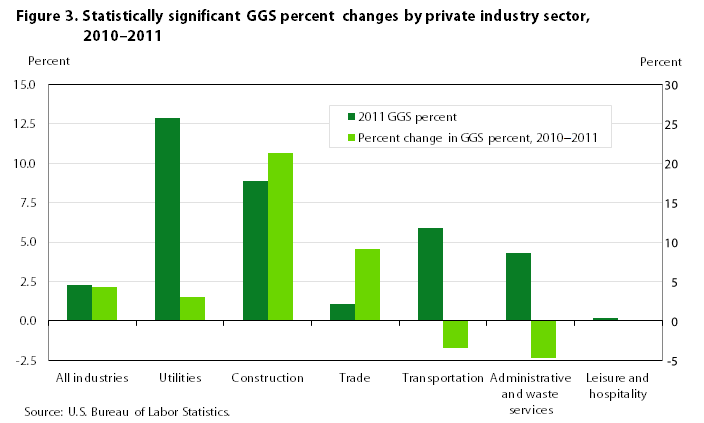
| Industry | 2011 GGS percent | Percent change in GGS percent, 2010‒2011 |
|---|---|---|
All industries | 2.3 | 4.3 |
Utilities | 12.9 | 3.1 |
Construction | 8.9 | 21.3 |
Trade | 1.1 | 9.1 |
Transportation | 5.9 | –3.4 |
Administrative and waste services | 4.3 | –4.7 |
Leisure and hospitality | 0.2 | 0.0 |
The trade sector had 223,079 green goods and services jobs in 2011, accounting for 1.1 percent of the industry’s employment. This sector had an increase of 17,512 green goods and services jobs (8.5 percent) over the year. Within the trade sector, the largest increase in green goods and services employment occurred in the miscellaneous durable goods merchant wholesalers industry group (NAICS 4239), which includes recyclable material merchant wholesalers and used merchandise stores. This industry group experienced an increase in green goods and services employment of 9,997. The green goods and services percent of this industry group also experienced the largest increase within the trade sector, growing from 34.4 percent to 36.1 percent.
Leisure and hospitality services had 23,696 green goods and services jobs in 2011 and increased by 3,054 green goods and services jobs (14.8 percent) over the year. The entire green goods and services jobs increase in this industry can be attributed to the museums, historical sites, and similar institutions industry group (NAICS 7121), which includes national parks and zoos. The proportion of the employment in the green goods and services group grew from 16.2 percent in 2010 to 18.1 percent in 2011.
Administrative and waste services had 335,417 green goods and services jobs in 2011, accounting for 4.3 percent of the sector’s employment. This sector had an increase of 4,767 green goods and services jobs (1.4 percent) over the year. The waste collection industry group (NAICS 5621) led the sector’s green goods and services employment growth with an increase of 6,336 in 2011. Remediation and other waste management services (NAICS 5629) had the second largest increase in this sector, with 4,093 green goods and services jobs added. Despite the growth in their green goods and services employment level, neither of these two industries experienced significant growth in the proportion of green goods and services jobs.
The number of green goods and services jobs edged down by 3,382 (–1.4 percent) in the transportation and warehousing sector. In 2011, the sector had 238,755 green goods and services jobs, for 5.9 percent of the sector’s employment. Commuter rail systems and charter bus services are examples of green goods and services within transportation and warehousing. The charter bus industry group (NAICS 4855) had the most significant change in this group, with a decrease of –2,132 green goods and services jobs between 2010 and 2011. The green goods and services employment rate in this industry group also decreased significantly, from 58.4 to 50.2 percent over the year, an 8.2 percentage point decrease.
Utilities had 71,129 green goods and services jobs in 2011. The utilities sector green goods and services employment rate grew from 12.5 percent in 2010 to 12.9 percent over the year. The private utilities sector added 2,098 green goods and services jobs, a 3.0 percent increase in 2011. Among the industries involved in private sector electric power generation, nuclear power had the highest green goods and services employment with 44,054 jobs in 2011. Hydroelectric power generation had the second largest green goods and services employment with 3,780 green goods and services jobs. Wind electric power generation was third with 2,724 green goods and services jobs, followed by biomass electric power generation (1,166), geothermal electric power generation (1,017), and solar electric power generation (522). Other electric power generation had 525 green goods and services jobs in 2011.
The public sector had 886,080 green goods and services jobs in 2011, or 4.2 percent of public sector employment. Over the year, government green goods and services employment decreased by 14,890 (–1.7 percent). In 2011, local government had the most green goods and services employment in the public sector, 424,201, representing 3.1 percent of total local government employment.
Within local government, the transportation and warehousing sector, which encompasses mass transit systems, had the largest green goods and services employment in local government with 209,063 jobs. The most significant change in green goods and services employment in local government occurred in the utilities sector, which lost 5,346 green goods and services jobs (–5.4 percent) over the year. Utilities within local government also sustained a significant decrease in the green goods and services employment rate, which decreased from 40.8 percent to 38.9 percent over the year.
Following an over-the-year loss of 7,685 green goods and services jobs, state government had 248,539 green goods and services jobs in 2011, accounting for 5.5 percent of state government employment. Public administration had the largest number of green goods and services jobs in state government, 164,952 (9 percent). This industry includes the enforcement of environmental regulations and the administration of environmental programs. The most significant change within state government occurred in the professional, scientific, and technical services sector, which includes engineering services. This sector lost 950 green goods and services jobs between 2010 and 2011. The green goods and services employment rate in the professional, scientific, and technical services industry decreased from 9 percent to 4 percent in the same period.
The federal government had 213,340 green goods and services jobs representing 7.5 percent of its total employment in 2011. As was the case with state government, most green goods and services jobs in the federal government were in the public administration sector, which had 139,884 green goods and services jobs in 2011. The professional, scientific, and technical services sector had the second largest green goods and services employment in federal government with 39,714 jobs. The most statistically significant change in green goods and services employment within the federal government, however, occurred in the utilities sector, which decreased by 713 green goods and services jobs.
Ten states had more than 100,000 green goods and services jobs in 2011: California (360,245), New York (266,308), Texas (227,532), Pennsylvania (167,397), Ohio (137,143), Illinois (136,447), Florida (117,433), North Carolina (108,094), Virginia (107,773), and Washington (101,593).
California had the highest green goods and services employment in the United States, representing 2.5 percent of the state’s total employment. Construction had the largest number of private sector green goods and services jobs in California, 54,070, representing 9.7 percent of total green goods and services employment in the state. Construction also had the most green goods and services employment growth, with 16,890 green goods and services jobs added over the year. Administrative and waste services (50,022); professional, scientific, and technical services (43,279); and manufacturing (36,417) were the next industry sectors with the most green goods and services jobs. Utilities had the most significant green goods and services employment rate growth, from 8.0 percent in 2010 to 13.6 percent in 2011, the highest green goods and services employment rate within the state’s private sector.
New York had the second most green goods and services jobs in the nation, representing 3.2 percent of the state’s total employment in 2011. In New York’s private sector, the transportation and warehousing industry had the most green goods and services jobs (38,670), followed by construction (30,657); professional, scientific, and technical services (21,830); and manufacturing (21,719). Construction had the most significant increase in green goods and services employment, growing by 15,828 over the year. This growth led the construction sector to have the highest increase in green goods and services employment rates among all private industry sectors in New York, growing from 4.9 to 10.0 percent.
Texas had the third largest green goods and services employment in the United States in 2011, with 2.2 percent of the state’s total employment being green goods and services jobs. Construction had the largest number of private sector green goods and services jobs in the state (46,559); followed by professional, scientific, and technical services (33,558); and manufacturing (27,554). Neither green goods and services employment nor green goods and services employment rate changed significantly in Texas between 2010 and 2011 for these sectors.
The District of Columbia had the highest percentage of green goods and services total employment of any jurisdiction measured, 5.1 percent, in 2011. Oregon had the next highest proportion of its employment in green goods and services jobs, 4.3 percent. California experienced the largest increase in green goods and services employment, with an additional 17,366 green goods and services jobs over the year. Maryland had the second largest increase in green goods and services employment, with 14,143 green goods and services jobs added between 2010 and 2011.
Data collection for the 2010 GGS survey began in May 2011, with the mailing of advance notification letters to sampled establishments informing them that they were selected to participate in the GGS survey. The first mailing of GGS survey forms commenced 2 weeks later, followed by a second form mailed to nonrespondents 6 weeks after the initial survey forms were mailed. A third and final form was mailed to select nonrespondents 12 weeks after the initial mailing. At the same time the third forms were mailed, BLS initiated the nonresponse prompting (NRP) process, which consisted of computer-assisted telephone interview (CATI) calls to nonrespondents. The NRP process occurred for 5 months, from July 2011 through November 2011. Edit reconciliation telephone calls commenced in November 2011 for units that BLS identified as needing additional review because of quality concerns, such as logic failures, unreadable data, or outlier responses. All data collection and reconciliation processes ended January 2012, and the final response rate for the 2010 GGS survey was 70.6 percent.
Data collection for the 2011 GGS survey began April 2012. This collection included the addition of an online data collection tool, which allowed respondents to answer the survey via Internet. The 2011 survey had 9,853 (11.1 percent) respondents submit responses online. A full breakdown of collection method by survey year can be seen in figure 4.
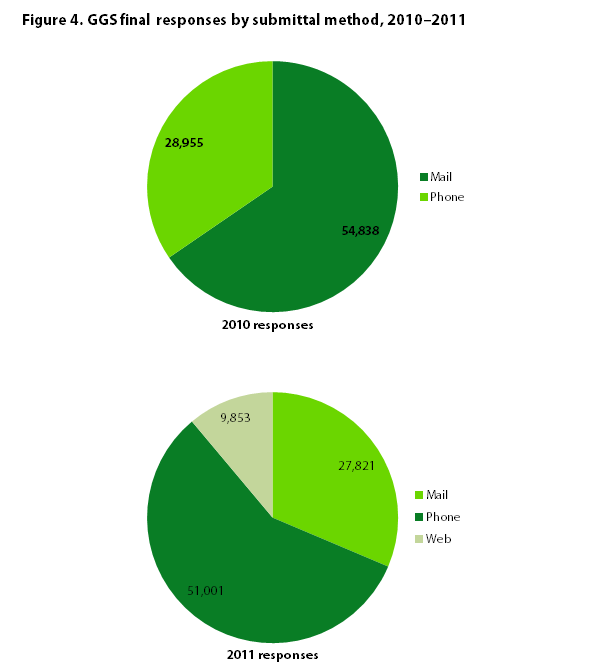
| Source | 2010 responses | 2011 responses |
|---|---|---|
| 54,838 | 27,821 | |
Phone | 28,955 | 51,001 |
Web | — | 9,853 |
GGS survey followed a schedule similar to the initial survey cycle for the 2010 data collection survey. Advance notification letters for the 2011 GGS data collection survey were mailed on April 25, 2012, followed 2 weeks later by the first mailing of GGS survey forms. A second mailing of forms was mailed to nonrespondents 6 weeks after the first mailing. Because of the low response rate from the third mailing during the 2010 data collection, the third mailing was eliminated in the 2011 collection period. Instead, CATI follow-up calls to nonrespondents commenced 3–4 weeks after the second mailing (July 2012), which contributed to the large increase in responses received by telephone in the 2011 collection. All data collection and reconciliation activities ended at the close of November 2012, achieving a final response rate of 74.1 percent. The 2011 GGS survey was completed in a timeframe 3 months shorter than that of the 2010 survey, yet achieved a higher response rate (see figure 5).
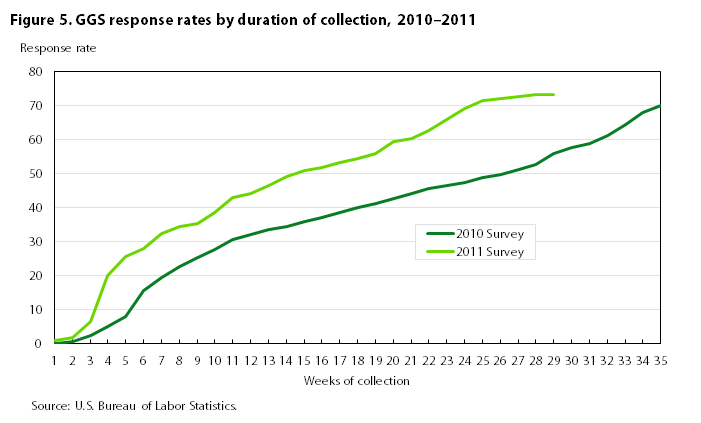
| Weeks | 2010 responses | 2011 responses |
|---|---|---|
Week 1 | 0.1 | 0.9 |
Week 2 | 0.8 | 1.9 |
Week 3 | 2.4 | 6.4 |
Week 4 | 5.1 | 20.1 |
Week 5 | 8.1 | 25.7 |
Week 6 | 15.6 | 28.1 |
Week 7 | 19.5 | 32.3 |
Week 8 | 22.6 | 34.4 |
Week 9 | 25.4 | 35.4 |
Week 10 | 27.8 | 38.5 |
Week 11 | 30.6 | 42.9 |
Week 12 | 32.0 | 44.2 |
Week 13 | 33.5 | 46.6 |
Week 14 | 34.3 | 49.2 |
Week 15 | 35.9 | 50.9 |
Week 16 | 37.2 | 51.9 |
Week 17 | 38.5 | 53.3 |
Week 18 | 40.0 | 54.6 |
Week 19 | 41.3 | 55.9 |
Week 20 | 42.7 | 59.5 |
Week 21 | 44.2 | 60.2 |
Week 22 | 45.5 | 62.6 |
Week 23 | 46.6 | 66.0 |
Week 24 | 47.4 | 69.0 |
Week 25 | 48.9 | 71.5 |
Week 26 | 49.9 | 72.2 |
Week 27 | 51.3 | 72.7 |
Week 28 | 52.7 | 73.3 |
Week 29 | 55.9 | 73.3 |
Week 30 | 57.7 | — |
Week 31 | 58.9 | — |
Week 32 | 61.1 | — |
Week 33 | 64.3 | — |
Week 34 | 68.0 | — |
Week 35 | 70.1 | — |
After establishing that the worksite provided a green good or service, BLS asked on the GGS survey forms for the percentage of GGS revenue or employment. An example of this section of the form can be seen in figure 6.
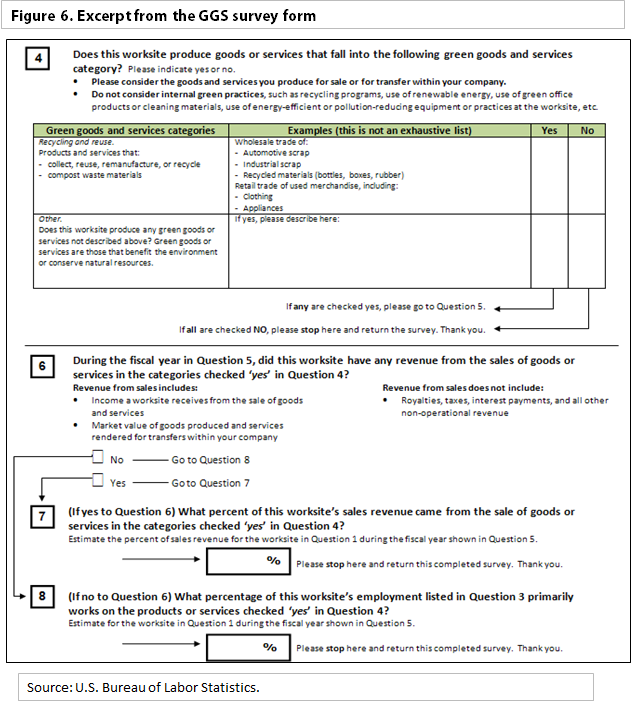
Through testing and discussions with potential respondents prior to conducting the initial survey, BLS determined that revenue shares for green products or services could be applied to establishments’ total employment to determine the green employment within an establishment. The collected green revenue share is applied to the establishments’ total employment, which BLS collects through the QCEW program, to calculate establishments’ green goods and services employment. For example, if an establishment generated 70 percent of its revenue from providing green goods or services, 70 percent of its total employment would be counted as green employment.
Response profiles from the 2010 collection indicated that 69 percent of GGS survey respondents had no products or services in the defined GGS survey categories, while 14 percent of establishments performed green goods and services activities exclusively. For the remaining 17 percent of respondents that produce both green and nongreen goods and services, we applied the green revenue share approach to determine the number of green goods and services jobs within their establishment.
The majority of sampled units within the 325 industries that constitute the green goods and services scope had no green goods and services revenue or employment, meaning they were not producers of green goods and services. Establishments that solely performed green goods and services activities (i.e., those reporting 100 percent green goods and services revenue/employment share) accounted for 57 percent of total green goods and services employment in each year.
Amanda L. Chadwick, Mark DeWolf, Nicholas A. Fett, and Robert L. Viegas, "Green Goods and Services survey: results and collection," Monthly Labor Review, U.S. Bureau of Labor Statistics, September 2013, https://doi.org/10.21916/mlr.2013.28
1 For additional background information, see Dixie Sommers, “BLS green jobs overview,” Monthly Labor Review, January 2013, pp. 3–16, https://www.bls.gov/opub/mlr/2013/01/art1full.pdf.
2 For more information about the discontinuation of the survey, go to https://www.bls.gov/bls/sequester_info.htm.
3 See U.S. Green Building Council article at http://www.usgbc.org/DisplayPage.aspx?CMSPageID=1852.